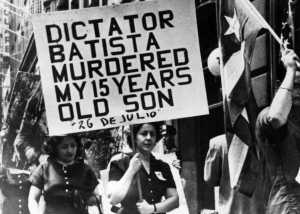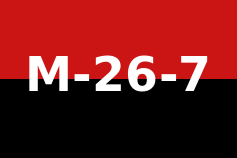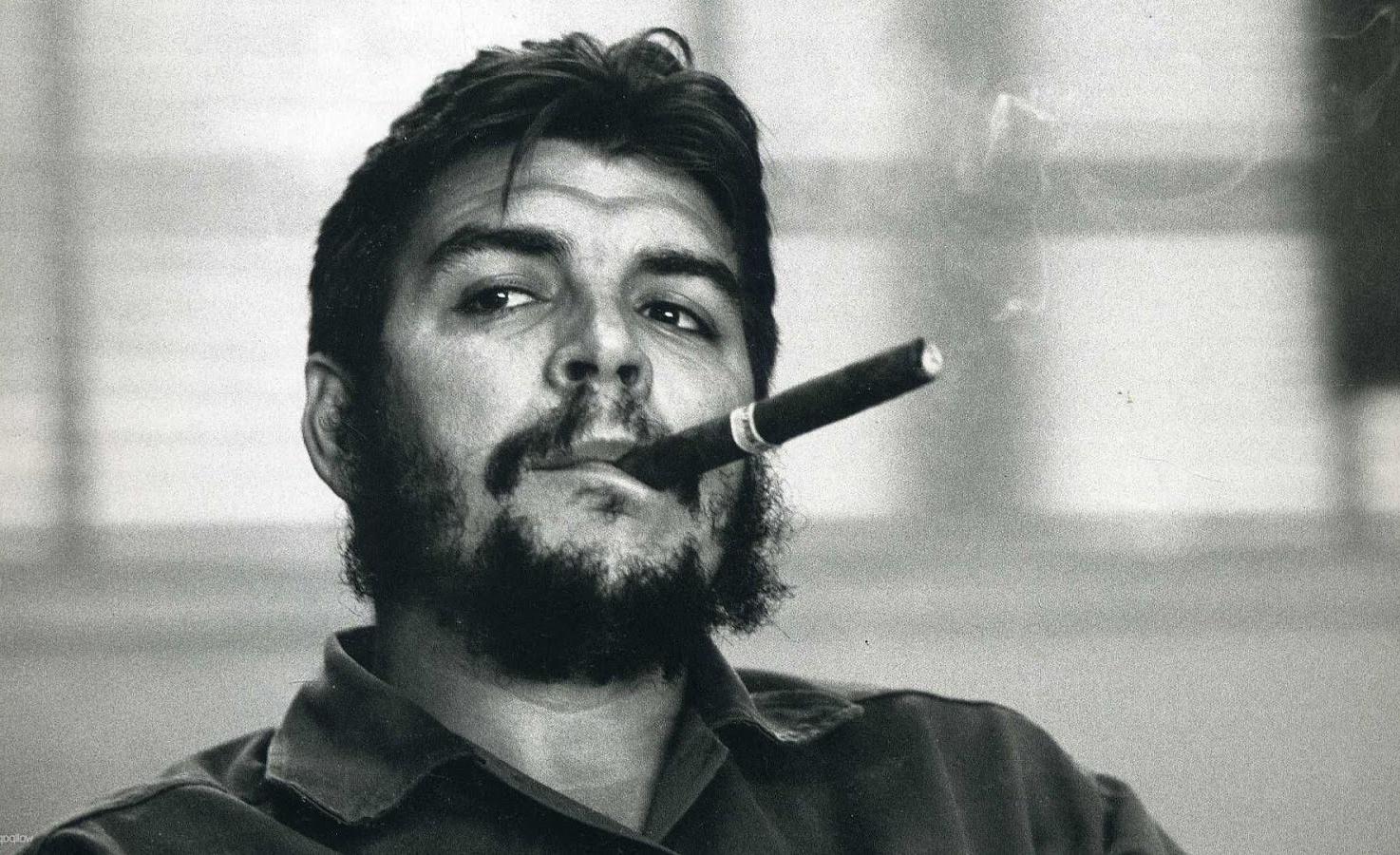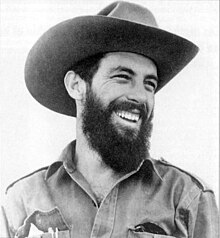For The Comrades: Heroes of the Revolution: Fidel Castro

El Comandante, Fidel Castro Ruz, Commander in Chief of the Cuban Revolution
Dates: July 26, 1953 - January 1, 1959
Factions Involved: Cuban Government, 26th of July Movement
Overview: One of the most significant events of the 20th century, The Cuban Revolution reshaped the perceived lines of power in the western world and inspired similar movements internationally to challenge the bourgeoisie and put power back into the hands of the people.

Colonel Fulgencio Batista Zaldivar, 9th and 12th President of Cuba
Corruption at its Finest: To understand the significance of the Cuban revolution, one must return to Cuba's history immediately after Cuban Independence from Spain and the subsequent powershifts which plagued the island for decades. The most stable of these governments began after the overthrow of Cuba's Gerardo Machado. Machado was a General in the Cuban Army who had fought in the Cuban War of Independence. He was overthrown by a military alliance of high ranking officers led by Batista.
The next 7 Cuban presidents were all puppets covertly installed by the military under the command of Colonel Batista. After engineering the political landscape in his favor over the course of a decade after the end of Spanish rule Colonel Batista was elected President of Cuba. He made the government unfavorable in the eyes of the Cuban people and ran a populist campaign, promising to fix the corruption while he himself was the cause.
As president Batista was popular because of his progressive policies and his drafting of the 1940 Cuban Constitution. In the mid 1940's after WWII Cuba was a very popular destination for American Tourists. Cuba had a flourishing casino market which was run by the American Mafia. Batista had close relations with the Mafia and frequently had visits with the mob in New York City. Brothels/Sex Houses were also very common in Cuba at the time. At the end of his term as President, Colonel Batista handpicked a successor who lost the election. Batista later retired and moved to New York for the next 8 years. He owned property in New York City and Daytona Beach, Florida. Batista returned to Cuba in the Early 1950's to resume activities in government and was reelected president.
Batista was not popular at all during his second term, Batista was initially supported by the Communist movement in Cuba because of his progressive policies. During his second term Batista was staunchly Anti-Communist and this earned him much praise from the United States. Batista allowed U.S. Businesses the freedom to operate in Cuba with very little benefit to the Cuban people. He was given money and gifts in exchange for political actions which he would then agree too. Batista's involvement with the Mafia and organized crime was so notable that he would frequently hold meetings with high profile gangsters such as Lucky Luciano and other mobsters who later took the formula for casinos used in Havana and used it to develop what would later become Las Vegas, Nevada.
By 1960, U.S. Companies owned 40% of all Cuban Sugar Fields, 80% of Cuban Cattle ranches, 90% of Mines, 100% of Cuba's oil industry and supplied 20% of all imports to Cuba. Good news for American business was terrible for the Cuban people. Batista's government murdered anyone who questioned his rule, revoked the right to strike and cut nearly all government assistance programs. Anyone who questioned this regime was shot or imprisoned.

Anti Batista Protest
According to President John F Kennedy nearly 20,000 people were killed by Batista for anti government speech.

Fidel Castro
Birth of Revolution: During this time period Fidel Castro was a young law student who had just returned from assisting a rebellion against dictator Rafael Trujillo who had been in power in the Dominican Republic for nearly 30 years earning him the nickname "El Jefe" or "The Boss". Trujillo supported the Batista government. A planned uprising involving nearly 1,200 men was discovered and many were arrested, Castro managed to escape. After returning to Cuba, Fidel Castro finished his studies graduating with a Doctorate in Law from the University of Havana. Castro became very vocal against U.S. policies in the Caribbean, as the U.S. propped up dictators in the Dominican Republic, Haiti and various other nations while exploiting the people living there much like was done in Cuba.
After graduating, Fidel Castro had attempted to challenge the Batista Government legally in court, Suing the government over its treatment of the poor and broken promises. Castro lost every time and his law firm was not economically viable. Castro cared very little for material possessions and did not charge his clients a fee. He had his office furniture repossessed and electricity cut off due to his inability to pay bills.
Batista shortly after enacted martial law and cracked down even more on any dissent.
During the 1953 election Fidel Castro was a candidate in the free election but it was canceled by the government. Fed up with the corruption Fidel Castro and his like minded followers launched a daring attack which could only be described as a suicide mission.

Flag of the 26th of July Movement
26th of July: On July 26, 1953, Fidel Castro, his brother Raul Castro and 135 other revolutionaries launched an attack on a Cuban Military Base in the city of Santiago. The group attacked the Moncada Barracks and failed almost immediately overwhelmed by a Cuban Army detachment of nearly 400 captured Fidel Castro and his group were arrested and sentenced to 15 years in prison. The Cuban people were outraged at the government and supported Castro and his group. While in prison Fidel Castro renamed his group the 26th of July movement as commemoration of that day. Castro also began to read the works of Karl Marx and other political thinkers. Imprisoned with him was the Argentine born rebel Che Guevara who was trained doctor and political activist.

Comandante Che Guevara
Che Guevara: Ernesto "Che" Guevara was born to an upper middle class family in Argentina to parents of Spanish and Irish background. His full name officially reads as Ernsesto Guevara Lynch. Although his parents had a fair amount of wealth his father was particularly supportive of revolutionaries in Spain and frequently hosted Spanish veterans in their home. Che was allowed to read all books from his fathers library which contained over 3,000 books. He was fond of poetry and philosophy and would sometimes do his own writing. From a very young age Che Guevara carried a deep affinity for the poor and the images of poverty and disease stuck with him until adulthood. He deeply wanted to challenge the capitalist policies which were exploiting people all across Latin America. A Declassified 1958 CIA Profile on Che Guevara remarked "Che is exceptionally well read for a Latino". Che was fluent in Spanish and French. While in Cuba as part of Fidel Castro's 26 of July movement, Che was imprisoned with Castro and introduced him to philosophy and other socialist works. Che had an ability to bond with the people wherever he went and this earned him the position of Chief Diplomat in the Castro Government later on.

Comrade Camilo Cienfuegos Gorriaran
Camilo Cienfuegos: Camilo was born in Havana to Spanish Immigrants to Cuba, His father was a tailor who was sympathetic to Left wing politics. Camilo became good friends with Fidel Castro and was hailed as a hero for winning several key battles for the revolution. He was a skilled tactician who was successful at guerilla warfare tactics.
These men along with Juan Almeida Bosque and Raul Castro formed the chief leadership of the revolution
On May 15, 1955 after mounting pressure from the Cuban people Batista granted Amnesty to Fidel Castro and 82 of his revolutionaries but were forced to leave Cuba. Fidel Castro and his men fled to Tuxpan, Veracruz, Mexico. Emulating a journey made by Cuban revolutionary Jose Marti made almost 60 years earlier. While in Mexico, Fidel Castro began the process of turning the 26th of July movement from a rag-tag group into a professional army capable of fighting the Cuban Army.

Cuban Postage Stamp commemorating the voyage of the Granma
The War Approaches: In 1956 after training in Tuxpan, Mexico Fidel Castro, Raul Castro and Che Guevara along with 80 other men departed Mexico on the Yacht Granma which also took them to Mexico. The ship was heavily weighed down, it was originally designed to be a 15 person pleasure with a maximum capacity of 25. It was now carrying 80 men and military supplies. The 26th of July Movement made their way back to Cuba intent on starting a war with the Cuban Military. The yacht arrived 2 days late due to being weighed down. The men arrived at Playa Las Coloradas a city friendly to the revolutionaries. The men made their way to Sierra Maestra mountains to link up with another detachment of the moment. While on the two day march to the mountains the group was attacked by the Cuban Army. Of the original 80 men from the Granma only 20 survived the attack. Dealt a major blow Castro dispersed his remaining forces.
Upon learning that the Communists were back in Cuba, other Anti Batista movements were sprouting in Cuba. An anti-communist movement called the Student Revolutionary Directorate, a group made up mostly of students attacked the presidential palace in Havana with the intentions of decapitating Batista. The group failed and were stopped by the Cuban Army. It is around this time the United States Government lost faith in Batista and imposed an Embargo as well as closing the U.S. Embassy and recalling U.S. Ambassadors.
The 26th of July Movement began to operate in numbers as few as 20 men at a time attacking Cuban Military assets one at a time and succeeding. The rebels attacked military positions in major Cuban cities from their positions in the mountains and if the attack was not successful they would retreat back to the mountains. The Cuban Military began to fracture and fall into chaos. The final battle of the Cuban Revolution put everything on the table for both sides.

Santa Clara, Republic of Cuba
Battle of Santa Clara: On September 28, 1958 a detachment of 340 men led by Che Guevara marched on the city of Santa Clara. Che Guevara divided his men into two columns. The first group was to attack a hill where Cuban Army soldiers were awaiting an armored train carrying weapons and supplies. The attack on the train was led by a young 23 year old rebel named Roberto Rodriguez. His attack was successful and the Cuban Army was routed from their positions. The train fell to the rebels, without resupply the Cuban Army would lose its ability to fight in the city.
The other group went with Che Guevara into the city to fight the Cuban Army forces. The civilians in the city were entirely supportive of the 26th of July movement and helped the rebels by making Molotov Cocktails.
After the capture of the train, The Cuban Military began printing that they were victorious in Santa Clara attempting to sway public opinion. Shortly after learning this the rebels had also captured the local radio stations and began broadcasting that they were the true victors. They had captured the City of Santa Clara and proclaimed they "were marching to Havana to take over the government". Cuban Army posts began to surrender to rebel commanders who showed up to their bases.
When Batista began to learn that his army was surrendering he began to make preparations to flee to the country and eventually left for the Dominican Republic before Castro's men could capture him.

Fidel Castro visiting the Lincoln Memorial
Aftermath: The Rebels began to transform the government to a Socialist model and began correcting the wrongs of the Batista dictatorship. All U.S. owned businesses were ousted and Cuban industry was reclaimed from American companies. 11 days after reforming the Cuban Government, Fidel Castro visited the United States and met with President Nixon whom he instantly hated. Castro's rise to power endangered U.S. Interests in Latin America. Castro encouraged other countries to also overthrow their dictators and challenge U.S. Imperialism. Castro's firm believe in Socialism meant that Cuba was destined to align itself with the Soviet Union instead of the United States. Meaning it was the only country in the "West" which was not directly on indirectly influenced by U.S. Foreign Policy. This greatly changed the perception of the U.S. worldwide.
U.S. Companies such as Dole Fruits and Chiquita Bananas encouraged the U.S. Government to maintain its dominance over Latin America for their own business interests. Rebel movements in other countries began to follow Castro's advice and went to war over control of their Fruits and Produce. Countries which had conflicts over fruit to the term "Banana Republics". (Sound familiar?)
Fidel Castro and his revolution proved that the people's will always prevails over imperialism and corruption and his courage inspired a generation of younger revolutionaries to action in Latin America and Africa.
"A revolution is not a bed of roses" - Fidel Castro
La Bayamesa
The Flag Raising Ceremony at the Cuban Embassy, Washington DC




0 Comments
Recommended Comments
There are no comments to display.
Create an account or sign in to comment
You need to be a member in order to leave a comment
Create an account
Sign up for a new account in our community. It's easy!
Join the herd!Sign in
Already have an account? Sign in here.
Sign In Now